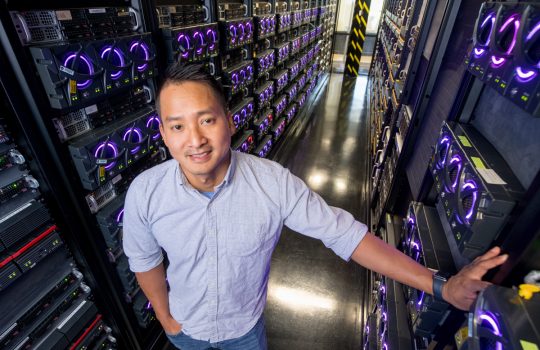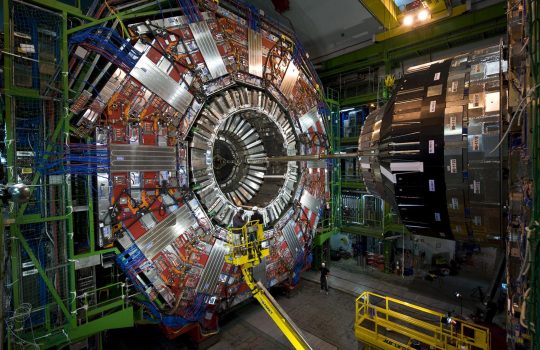Batavia, IL and Upton, NY—The world’s largest computing grid is ready to tackle mankind’s biggest data challenge from the earth’s most powerful accelerator. Today, three weeks after the first particle beams were injected into the Large Hadron Collider (LHC), the Worldwide LHC Computing Grid combines the power of more than 140 computer centers from 33 countries to analyze and manage more than 15 million gigabytes of LHC data every year.
The United States is a vital partner in the development and operation of the WLCG. Fifteen universities and three U.S. Department of Energy (DOE) national laboratories from 11 states contribute their power to the project.
“The U.S. has been an essential partner in the development of the vast distributed computing system that will allow 7,000 scientists around the world to analyze LHC data, complementing its crucial contributions to the construction of the LHC,” said Glen Crawford of the High Energy Physics program in DOE’s Office of Science. DOE and the National Science Foundation support contributions to the LHC and to the computing and networking infrastructures that are an integral part of the project.
U.S. contributions to the Worldwide LHC Computing Grid are coordinated through the Open Science Grid, a national computing infrastructure for science. The Open Science Grid not only contributes computing power for LHC data needs, but also for projects in many other scientific fields including biology, nanotechnology, medicine and climate science.
“Particle physics projects such as the LHC have been a driving force for the development of worldwide computing grids,” said Ed Seidel, director of the National Science Foundation’s Office of Cyberinfrastructure. “The benefits from these grids are now being reaped in areas as diverse as mathematical modeling and drug discovery.”
“Open Science Grid members have put an incredible amount of time and effort in developing a nationwide computing system that is already at work supporting America’s 1,200 LHC physicists and their colleagues from other sciences,” said Open Science Grid Executive Director Ruth Pordes from DOE’s Fermi National Accelerator Laboratory.
Dedicated optical fiber networks distribute LHC data from CERN in Geneva, Switzerland to eleven major “Tier-1” computer centers in Europe, North America and Asia, including those at DOE’s Brookhaven National Laboratory in New York and Fermi National Accelerator Laboratory in Illinois. From these, data is dispatched to more than 140 “Tier-2” centers around the world, including twelve in the United States.
“Our ability to manage data at this scale is the product of several years of intense testing,” said Ian Bird, leader of the Worldwide LHC Computing Grid project. “Today’s result demonstrates the excellent and successful collaboration we have enjoyed with countries all over the world. Without these international partnerships, such an achievement would be impossible.”
“When the LHC starts running at full speed, it will produce enough data to fill about six CDs per second,” said Michael Ernst, director of Brookhaven National Laboratory’s Tier-1 Computing Center. “As the first point of contact for LHC data in the United States, the computing centers at Brookhaven and Fermilab are responsible for storing and distributing a great amount of this data for use by scientists around the country. We’ve spent years ramping up to this point, and now, we’re excited to help uncover some of the numerous secrets nature is still hiding from us.”
Physicists in the U.S. and around the world will sift through the LHC data torrent in search of tiny signals that will lead to discoveries about the nature of the physical universe. Through their distributed computing infrastructures, these physicists also help other scientific researchers increase their use of computing and storage for broader discovery.
“Grid computing allows university research groups at home and abroad to fully participate in the LHC project while fostering positive collaboration across different scientific departments on many campuses,” said Ken Bloom from the University of Nebraska-Lincoln, manager for seven Tier-2 sites in the United States.
Information about LHC Grid Fest is available at: http://www.fnal.gov/gridfest/
Notes to editors
Grid computing and Large Hadron Collider images are available at www.uslhc.us/Images.
More information about U.S. computing for the LHC, including a list of U.S. institutions involved in the Worldwide LHC Computing Grid, is available at http://www.uslhc.us/The_US_and_the_LHC/Computing
U.S. support for LHC participation
The U.S. Department of Energy (DOE) and the National Science Foundation (NSF) invested a total of $531 million in the construction of the Large Hadron Collider and the ATLAS and CMS detectors. DOE provided $200 million for the construction of critical LHC accelerator components, $250 million for the design and construction of the ATLAS and CMS detectors, and continues to support U.S. scientists’ work on the detectors and accelerator R&D. NSF has focused its support on funding university scientists who have contributed to the design and construction of CMS and ATLAS ($81 million). In addition, both agencies promote the development of advanced computing innovations to meet the enormous LHC data challenge. More than 1,700 scientists, engineers, students and technicians from 94 U.S. universities and laboratories (full list at http://www.uslhc.us/The_US_and_the_LHC/Collaborating_Institutions ) participate in the LHC and its experiments.
LHC Computing Grid participants
Signatories to the Worldwide LHC Computing Grid are: Australia, Austria, Belgium, Canada, China, the Czech Republic, Denmark, Estonia, Finland, France, Germany, Hungary, Italy, India, Israel, Japan, Republic of Korea, the Netherlands, Norway, Pakistan, Poland, Portugal, Romania, the Russian Federation, Slovenia, Spain, Sweden, Switzerland, Taipei, Turkey, the United Kingdom, Ukraine, and the United States of America.
Brookhaven National Laboratory is operated and managed for DOE’s Office of Science by Brookhaven Science Associates. Visit Brookhaven Lab’s electronic newsroom for links, news archives, graphics, and more: http://www.bnl.gov/newsroom.
Fermilab is a DOE Office of Science national laboratory, operated under contract by the Fermi Research Alliance, LLC. The Department of Energy Office of Science is the nation’s single-largest supporter of basic research in the physical sciences.
The Open Science Grid is a national distributed computing grid for data-intensive research, supported by the U.S. Department of Energy and the National Science Foundation. Visit www.opensciencegrid.org.
CERN, the European Organization for Nuclear Research, is the world’s leading laboratory for particle physics. It has its headquarters in Geneva. At present, its Member States are Austria, Belgium, Bulgaria, the Czech Republic, Denmark, Finland, France, Germany, Greece, Hungary, Italy, Netherlands, Norway, Poland, Portugal, Slovakia, Spain, Sweden, Switzerland and the United Kingdom. India, Israel, Japan, the Russian Federation, the United States of America, Turkey, the European Commission and UNESCO have Observer status.



